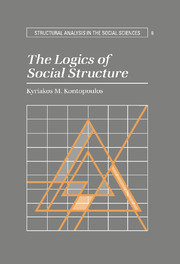Book contents
- Frontmatter
- Contents
- Preface
- Introduction
- Part I Metatheoretical considerations
- Part II Compositionist logics
- Part III Logics of hierarchy
- Part IV Heteracrchical logics
- Part V The phenomenology of social structures
- 12 Modalities and systems of interaction
- 13 Heterarchical levels of social structure
- 14 On structural totalities
- 15 In conclusion
- Appendix: The logics of structuration
- Glossary
- Bibliography
- Index
14 - On structural totalities
Published online by Cambridge University Press: 24 October 2009
- Frontmatter
- Contents
- Preface
- Introduction
- Part I Metatheoretical considerations
- Part II Compositionist logics
- Part III Logics of hierarchy
- Part IV Heteracrchical logics
- Part V The phenomenology of social structures
- 12 Modalities and systems of interaction
- 13 Heterarchical levels of social structure
- 14 On structural totalities
- 15 In conclusion
- Appendix: The logics of structuration
- Glossary
- Bibliography
- Index
Summary
The final level of structural emergence (level III) is that of structural totalities. Here the exemplary forms are those of class structures, national societal structures (“social formations” in general), and the world-system. These structures must be considered “global,” in the sense that they are taken to be overarching, all-inclusive, organizing entities heterarchically constraining/enabling/availing to and, thus, relatively reorganizing more or less all the lower structures. I am using the term “totalities” to indicate two basic characteristics of the structural systems at this global level: First, their “inclusive” nature (since they include within them – though without absorbing or controlling – the lower-level structural systems; and, second, their “totalizing” nature, that is, the growth of several strong collective powers within them and the contestation and assumption by one or more of these powers of the hegemonic role of redefining and reorganizing the national societies – and, to the extent possible, the world-system – on the basis of their “vision” and their “project.” I presume that these powers are, primarily, social “classes” and, secondarily, other “classlike” collective agencies (“social categories,” such as bureaucracies or professionals).
Two different conceptions of totalities already have been advanced, one by Hegel and various neo-Hegelian versions (historicist, hermeneutical) (Gadamer 1975; Taylor 1975, 1979) and the other by contemporary structuralists, especially Althusser (1970a and b; in the following I cite Althusser and Balibar 1970 as Althusser 1970b).
(A) The Hegelian notion of totality posits a unifying essence behind the apparent multiplicity of phenomena
- Type
- Chapter
- Information
- The Logics of Social Structure , pp. 304 - 325Publisher: Cambridge University PressPrint publication year: 1993



